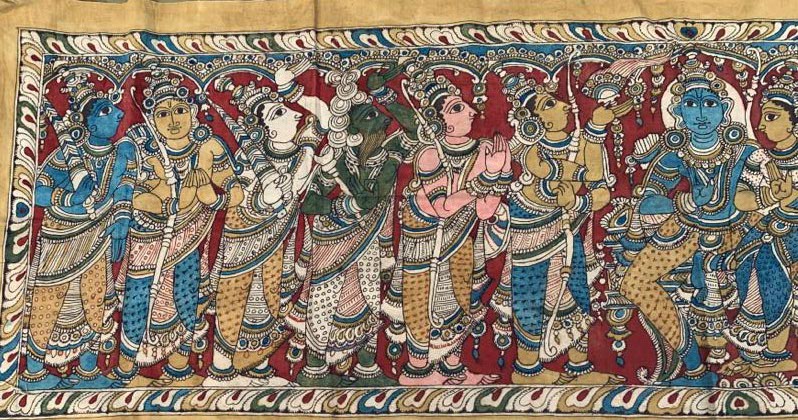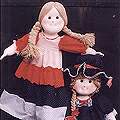
Natural Dyes, Pigments, Colours, Saris/Unstitched Garments, Textiles, Weaving, Spinning, Khadi
Hand Block – Printing/ Kalamkari of Machilipatnam, Andhra Pradesh
Kalamkari is the earliest and more complex techniques of block-printing on cloth using vegetable dyes. This flourished at Masulipatnam in Andhra Pradesh. The origin of the word kalamkari is from kalam or pen and kari or work. The kalamkari done here is a mixture of painting and hand-printing. This craft was started in the old city of Golconda after which it spread along the eastern coast up to Tamil Nadu. Originally known as Coromandel chintz, the textiles produced here are famous the world over.
The process followed is complex and intricate, and the blocks used are made by specialist artisans. These blocks have very detailed and elaborate designs carved on them. The fastness of the colours is ensured by washing, bleaching, and sunning. Mordants like alum are used to fix the colours onto the cloth. Wax is used as the resist agent when a combination of colours are used to embellish different parts of the design. The wax-resist is hand-printed on to the fabric with a kalam or pen made of an iron loop attached to a bamboo stick. This step is done before the application of indigo. After the wax is removed by boiling, other colours are applied. The detailed colouring is done with a brush. Running water is used for washing and the process takes several days, weeks, or months depending on the length of the cotton cloth.
This craft reached its zenith during British rule and was also in high demand as dress and furnishing material in Europe and Southeast Asia. The motifs used were floral and animal designs. The Persian influence on the designs is visible: ornamental birds, flowers, creepers, and mehrabs or archways found chiefly in Mughal architecture are common.
Hand block printing evolves from the dye painted fabrics of Coromandel Coast referred to as Machilipatnam paintings. These paintings were renowned trade items of seventeenth century mainly to European countries and Iran. The fabrics were referred to as Kalamkari because earlier the mordant was painted with a kalam (pen). Eventually the kalam’s were replaced by blocks in the nineteenth century. The border patterns and a field of floral pattern in a repetitive fashion displaced the early designs.
Locally the printed fabrics were used as prayer mats, tents and canopies. The European market brought the fashion for printed home furnishings and home linens etc.
Block printing is a labour intensive process that is done in several stages. The cloth is prepared by bleaching, washing and dipping in myrobalam solution. Fabric is then printed in black and red colour; the black is produced by iron nails and red that is obtained from alum. The fabric is then dyed in alizarine and starched. The starched fabric in the last is painted with yellow colour. Earlier natural dyes were used but due to the increased prices of raw material craftsmen have shifted to chemical dyes.
There has been degradation in the type of quality of craftsmanship now. Bigger block with large patterns have replaced the fine delicate foliage.
Kalamkari hand-painting on fabric is a technique used to embellish temple cloth and hangings. Painted hangings are used for religious instruction, in temples, and for draping behind the idol in temple cars during processions.
The process followed here is even more painstaking than the kalamkari done at Masulipatnam as the entire design is drawn bv hand using a kalam or pen made from wood (tamarind twigs charred to charcoal sticks) and fibre. All the processes are nearly the same as at Masulipatnam except for the absence of blocks. This craft grew mainly around places of pilgrimage and one of the leading centre is Sri Kalahasti in Andhra Pradesh.
The temple hangings and tapestries from Kalahasti are famous worldwide. Madder and indigo processes are used here and alum is the mordant used to fix the colours. Vegetable dyes in deep rich shades red and blue are used, while green is obtained as a combination of yellow and blue. The washing of the cloth to remove starch and the washing between dyeing and bleaching is done from flowing water in a stream or river. The lines of the design are drawn with a mixture of iron-filings and molasses. The colour schemes used are traditional ones, with women figures in yellow, gods in blue, and demons in red and green. The background colours are usually red with motifs of lotus and other flowers. The aesthetic quality of fine kalamkaris derives from the superb conceptual and technical skill involved in the work.
Religious themes dominate, with temples, epics, and mythological figures being depicted frequently. The stories illustrated on these panels are from Puranic legends and from the Ramayana and the Mahabharata. Paintings are usually done in cloth panels which narrate entire stories, with the smaller ones depicting important religious events like Sita’s marriage. As all the panels are done by hand, and each one is unique; no two panels will look the same. A panel may include a story-theme written in verse under it to explain it.
Gallery
YOUR VIEWS
PRACTITIONERS: INDIA
Access 70,000+ practitioners in 2500+ crafts across India.
BIBLIOGRAPHY
10,000+ listings on arts, crafts, design, heritage, culture etc.
GLOSSARY
Rich and often unfamiliar vocabulary of crafts and textiles.
SHOP at India InCH
Needs to be written.





